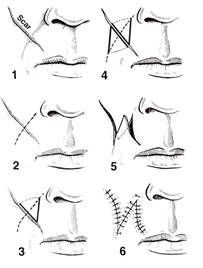
A plastic surgeon? Yes. A magician? No.
When there is a cut through the skin, the skin needs to heal. To heal, it needs to lay down new collagen, which is never as organized as the collagen you are born with. Disorganized, heaped up collagen is the definition of a scar.
So what do plastic surgeons do to avoid scars? Well, we either try not to cut through the skin or do it in such a way as to minimize the scar. We often use lasers to avoid a full thickness injury to the skin, thus avoiding scar formation. Some topical treatments like chemical peels, laser resurfacing or dermabrasion, can alter the skin, but, because they don’t cut through it, rarely cause scarring.
What if a cut through the skin is necessary or is the result of an accident? First and foremost, we handle the skin as delicately as possible taking care not to unnecessarily damage tissues. We try to preserve vital blood supply and repair muscle as well, and close the wound or incision with no tension on the skin for the best possible healing.
Secondly, we place the incision where it will be as unnoticeable as possible. The incision for a facelift, for example, uses the architecture of the ear to hide the scar, hugging the edges of normal anatomy and taking advantage of shadows. We also use the natural lines of the face, what we call the relaxed tension lines—like crows feet–to blend scars in.
Lastly we can change the direction and placement of scars with local skin flaps like z-plasties. A z-plasty can change a straight line scar that creases the skin to a zig-zag that acts like an accordion stretching over the area. Using local flaps, we can borrow from nearby areas with skin to spare and bring it to areas that need it to soften a scar.
And if the scar can’t be moved or hidden or surgically improved? That’s when we use pulsed dye lasers to decrease redness, or dermabrasion to sand down raised scars. Sometimes we use steroid injections to decrease itching and inflammation or topical silastic dressings to flatten scars.
The bottom line: If you have surgery, you are going to have scars. There’s no real way around it. It’s up to the plastic surgeon to make them as subtle as possible.




